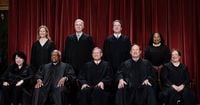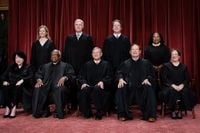As the gavel falls on October 6, 2025, the United States Supreme Court embarks on what many legal experts are calling its most consequential term in decades. The justices face a docket brimming with cases that test the very boundaries of presidential power, voting rights, and LGBTQ protections—issues that ripple far beyond the marble halls of the court and into the heart of a deeply divided nation.
This term, the Court’s conservative majority, which has already shown a willingness to support President Donald Trump’s bold assertions of executive authority in preliminary rulings, will confront the full weight of his legal agenda. According to the Associated Press, the justices will decide, over the next ten months, on some of Trump’s most controversial efforts—decisions that could redefine the balance of power in American government and society.
One of the most striking moments so far came when liberal Justice Ketanji Brown Jackson took aim at a decision allowing the Trump administration to cut $783 million in research funding. In a sharply worded dissent, Jackson invoked the whimsical logic of a classic comic strip, writing, "This is Calvinball jurisprudence with a twist. Calvinball has only one rule: There are no fixed rules. We seem to have two: that one, and this administration always wins." Her words captured the frustration felt by those who see the Court’s recent moves as lacking consistency and tilting toward the current administration.
But the coming term promises more than rhetorical fireworks. In early November, the justices will hear arguments on the legality of Trump’s sweeping tariffs, imposed under an emergency powers law. This case sits at the core of Trump’s economic agenda. Two lower courts have already concluded that the president does not have the unilateral authority to impose wide-ranging tariffs—arguing that such actions usurp Congress’s exclusive power to tax. The Trump administration, however, maintains that the law gives the president broad leeway to regulate imports, including through tariffs. Four dissenting judges on a federal appeals court have sided with this view, paving the way for what could be a defining Supreme Court showdown.
December will bring another test of executive power, as the Court examines whether Trump can fire independent agency members at will. The case could overturn, or at least drastically narrow, a 90-year-old precedent that required the president to show cause, such as neglect of duty, before removing Senate-confirmed officials. The conservative justices have already allowed these firings to proceed while the case moves forward, even after lower courts found them illegal. The three liberal justices have dissented each time, underscoring the ideological fault lines that define today’s Court.
Not all eyes are on economic or administrative law. Another case looming on the horizon could reshape the very definition of American citizenship. The Court is set to consider Trump’s executive order denying birthright citizenship to children born in the United States to parents who are in the country illegally or temporarily. Lower courts have blocked the order as unconstitutional, referencing more than 125 years of precedent and an 1898 Supreme Court ruling. The administration’s appeal is expected to be argued in late winter or early spring of 2026, setting the stage for a historic decision.
Meanwhile, the Court is preparing to hear a case that could dramatically alter the political landscape for minority voters. In mid-October, justices will hear arguments over congressional redistricting in Louisiana—a case that could affect electoral districts with majorities of Black, Hispanic, or Native American voters. Louisiana, now led by Republicans, has abandoned its defense of a map that elected two Black members of Congress. Instead, the state wants the Court to reject any consideration of race in redistricting, a move that, according to voting rights experts cited by the Associated Press, could effectively eliminate most majority-Black House districts in the South and fundamentally reshape the Voting Rights Act.
Chief Justice John Roberts and the conservative bloc have signaled skepticism toward the use of race in public policy, including their 2023 decision that ended affirmative action in college admissions. The fact that the Court is taking a second round of arguments in this redistricting case is unusual—and, as history shows (think Citizens United in 2010), sometimes signals a major shift in the law.
Campaign finance is also on the docket. The justices are reviewing an appellate ruling that upheld a decades-old provision of federal election law limiting how much political parties can coordinate spending with candidates for Congress and president. Republicans, including the Trump administration, are pushing to remove these limits, while Democrats want the law left intact. No date has been set for arguments, but the Court’s recent track record—striking down one campaign finance regulation after another—suggests the outcome could further loosen restrictions on money in politics.
LGBTQ rights are under the microscope as well. More than two dozen states have enacted laws barring transgender women and girls from participating in certain sports competitions. The Supreme Court is now hearing cases from Idaho and West Virginia, where lower courts sided with transgender athletes. While the Court in June upheld a ban on gender-affirming care for transgender youth, it pointedly did not address broader questions about transgender rights. The current cases raise constitutional questions about equal treatment and the reach of Title IX, the federal law that expanded opportunities for women and girls in public school and college sports. No date has been set for arguments, but the stakes are high for students and families nationwide.
Beyond the cases themselves, the composition of the Court is also a topic of speculation. Justice Samuel Alito, who turns 76 in April 2026, is rumored to be considering retirement. As the Associated Press notes, stepping down next summer would allow Trump to appoint a younger, like-minded conservative who would likely be confirmed by a Republican-led Senate. Alito, however, has kept his plans close to the vest, only recently signing a book contract after nearly two decades on the bench. Meanwhile, Justice Clarence Thomas, now 77, shows no signs of leaving. He is poised to become the longest-serving justice in U.S. history by 2028.
Legal scholars and court-watchers are bracing for a term that could deepen the nation’s political divides. As Irv Gornstein, executive director of the Supreme Court Institute at Georgetown University, put it, "If the same conservative-liberal split that has marked so many of Trump’s emergency appeals endures, we are in for one of the most polarizing terms yet." With so much at stake—from the powers of the presidency to the rights of voters and marginalized communities—the Court’s decisions in the coming months will reverberate for generations.
As the justices take their seats and the arguments unfold, Americans from every walk of life will be watching closely, aware that the outcomes could reshape the nation’s legal and political landscape in ways both profound and unpredictable.



